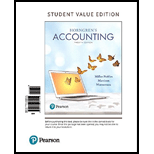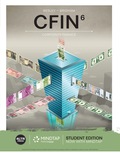
Horngren's Accounting, Student Value Edition Plus MyLab Accounting with Pearson eText -- Access Card Package (12th Edition)
12th Edition
ISBN: 9780134642932
Author: Tracie L. Miller-Nobles, Brenda L. Mattison, Ella Mae Matsumura
Publisher: PEARSON
expand_more
expand_more
format_list_bulleted
Concept explainers
Textbook Question
Chapter 1, Problem 1.1DC
Decision Case 1-1 Let’s examine a case using Greg's Tunes and Sal's Silly Songs. It is now the end of the first year of operations, and both owners want to know how well each business came out at the end of the year. Neither business kept complete accounting records, and neither owner made any withdrawals. The businesses throw together the data shown below at year-end:
| Sal's Silly Songs: | |
| Total Assets | $ 23,000 |
| Owner contribution | 8,000 |
| Total Revenues | 35,000 |
| Total Expenses | 22,000 |
| Greg's Tunes: | |
| Total Liabilities | $ 10,000 |
| Owner contribution | 6,000 |
| Total Expenses | 44,000 |
| Net Income | 9,000 |
To gain information for evaluating the businesses, the owners ask you several questions. For each answer, you must show your work to convince the owners that you know what you are talking about.
Requirements
- Which business has more assets?
- Which business owes more to creditors?
- Which business has more owner's equity at the end of the year?
- Which business brought in more revenue?
- Which business is more profitable?
- Which of the foregoing questions do you think is most important for evaluating these two businesses? Why?
- Which business looks better from a financial standpoint?
Expert Solution & Answer
Want to see the full answer?
Check out a sample textbook solution
Students have asked these similar questions
Joe transferred land worth $200,000, with a tax basis of $40,000, to JH Corporation, an existing entity, for 100 shares of its stock. JH Corporation has two other shareholders, Ethan and Young, each of whom holds 100 shares. With respect to the transfer:a. Joe has no recognized gain. b. JH Corporation has a basis of $160,000 in the land.c. Joe has a basis of $200,000 in his 100 shares in JH Corporation. d. Joe has a basis of $40,000 in his 100 shares in JH Corporation. e. None of the above.
I need help with this general accounting problem using proper accounting guidelines.
I am looking for the correct answer to this general accounting problem using valid accounting standards.
Chapter 1 Solutions
Horngren's Accounting, Student Value Edition Plus MyLab Accounting with Pearson eText -- Access Card Package (12th Edition)
Ch. 1 - Prob. 1QCCh. 1 - Which of the following is not an external user of...Ch. 1 - Prob. 3QCCh. 1 - Prob. 4QCCh. 1 - Prob. 5QCCh. 1 - Which of the following requires accounting...Ch. 1 - At the end of a recent year, Global Cleaning...Ch. 1 - Consider the overall effects on Global Cleaning...Ch. 1 - Assume that Global Cleaning Service performed...Ch. 1 - The balance sheet reports the Learning Objective 5...
Ch. 1 - Assume Global Cleaning Service had net income of...Ch. 1 - What is accounting?Ch. 1 - Prob. 2RQCh. 1 - Prob. 3RQCh. 1 - Prob. 4RQCh. 1 - Prob. 5RQCh. 1 - Prob. 6RQCh. 1 - Prob. 7RQCh. 1 - A business purchases an acre of land for $5,000....Ch. 1 - What does the going concern assumption mean for a...Ch. 1 - Which concept states that accounting information...Ch. 1 - Financial statements in the United States are...Ch. 1 - Prob. 12RQCh. 1 - What is the accounting equation? Briefly explain...Ch. 1 - What are two ways that equity increases? What are...Ch. 1 - How is net income calculated? Define revenues and...Ch. 1 - What are the steps used when analyzing a business...Ch. 1 - List the four financial statements. Briefly...Ch. 1 - What is the calculation for ROA? Explain what ROA...Ch. 1 - Prob. S1.1SECh. 1 - Determining organizations that govern accounting...Ch. 1 - Identifying types of business organizations...Ch. 1 - Prob. S1.4SECh. 1 - Applying accounting assumptions and principles...Ch. 1 - Prob. S1.6SECh. 1 - Using the accounting equation Learning Objective 3...Ch. 1 - Identifying accounts Learning Objective 3 Consider...Ch. 1 - Prob. S1.9SECh. 1 - Using the accounting equation to analyze...Ch. 1 - Identifying accounts on the financial statements...Ch. 1 - Preparing the income statement Learning Objective...Ch. 1 - Preparing the statement of owner’s equity Learning...Ch. 1 - Prob. S1.14SECh. 1 - Preparing the statement of cash flows Learning...Ch. 1 - Calculating ROA Learning Objective 6 Matured Water...Ch. 1 - Prob. E1.17ECh. 1 - Prob. E1.18ECh. 1 - 1. Accounting equation a. An economic resource...Ch. 1 - Using the accounting equation Learning Objective 3...Ch. 1 - E1-21 Using the accounting equation Learning...Ch. 1 - Using the accounting equation Learning Objective 3...Ch. 1 - Using the accounting equation Learning Objective 3...Ch. 1 - E1-24 Using the accounting equation Learning...Ch. 1 - Using the accounting equation to analyze...Ch. 1 - Using the accounting equation to analyze business...Ch. 1 - Using the accounting equation to analyze business...Ch. 1 - Using the accounting equation to analyze business...Ch. 1 - Using the accounting equation to analyze business...Ch. 1 - Preparing the financial statements Learning...Ch. 1 - Preparing the income statement Learning Objective...Ch. 1 - Prob. E1.32ECh. 1 - Prob. E1.33ECh. 1 - Prob. E1.34ECh. 1 - Preparing the statement of owner’s equity Learning...Ch. 1 - Prob. E1.36ECh. 1 - Prob. E1.37ECh. 1 - Jan. 1 The owner contributed an additional $5,000...Ch. 1 - Calculating Return on Assets Learning Objective 6...Ch. 1 - Using the accounting equation for transaction...Ch. 1 - Prob. P1.41APGACh. 1 - P1-42A Preparing financial statements Learning...Ch. 1 - Preparing financial statements Learning Objective...Ch. 1 - Prob. P1.44APGACh. 1 - Using the accounting equation for transaction...Ch. 1 - Using the accounting equation for transaction...Ch. 1 - Using the accounting equation for transaction...Ch. 1 - Using the accounting equation for transaction...Ch. 1 - Preparing financial statements Presented here are...Ch. 1 - Prob. P1.50BPGBCh. 1 - Prob. P1.51BPGBCh. 1 - Using the accounting equation for transaction...Ch. 1 - Using the accounting equation for transaction...Ch. 1 - Prob. P1.54CTCh. 1 - P1-55 is the first problem in a continuing problem...Ch. 1 - Prob. 1.1TIATCCh. 1 - Decision Case 1-1 Let’s examine a case using...Ch. 1 - The tobacco companies have paid billions because...Ch. 1 - Prob. 1.1FCCh. 1 - Prob. 1.1FSC
Knowledge Booster
Learn more about
Need a deep-dive on the concept behind this application? Look no further. Learn more about this topic, accounting and related others by exploring similar questions and additional content below.Similar questions
- accounting question?arrow_forwardThree individuals form JEY Corporation with the following contributions: Joe, cash of $50,000 for 50 shares; Ethan, land worth $20,000 (basis of $11,000) for 20 shares; and Young, cattle worth $9,000 (basis of $6,000) for 9 shares and services worth $21,000 for 21 shares. a. These transfers are fully taxable and not subject to § 351. b. Young’s basis in her stock is $27,000. c. Young’s basis in her stock is $6,000. d. Ethan’s basis in his stock is $20,000. e. None of the above.arrow_forwardNonearrow_forward
arrow_back_ios
SEE MORE QUESTIONS
arrow_forward_ios
Recommended textbooks for you
 Financial Accounting: The Impact on Decision Make...AccountingISBN:9781305654174Author:Gary A. Porter, Curtis L. NortonPublisher:Cengage Learning
Financial Accounting: The Impact on Decision Make...AccountingISBN:9781305654174Author:Gary A. Porter, Curtis L. NortonPublisher:Cengage Learning College Accounting, Chapters 1-27AccountingISBN:9781337794756Author:HEINTZ, James A.Publisher:Cengage Learning,
College Accounting, Chapters 1-27AccountingISBN:9781337794756Author:HEINTZ, James A.Publisher:Cengage Learning,

Financial Accounting: The Impact on Decision Make...
Accounting
ISBN:9781305654174
Author:Gary A. Porter, Curtis L. Norton
Publisher:Cengage Learning

College Accounting, Chapters 1-27
Accounting
ISBN:9781337794756
Author:HEINTZ, James A.
Publisher:Cengage Learning,


The accounting cycle; Author: Alanis Business academy;https://www.youtube.com/watch?v=XTspj8CtzPk;License: Standard YouTube License, CC-BY